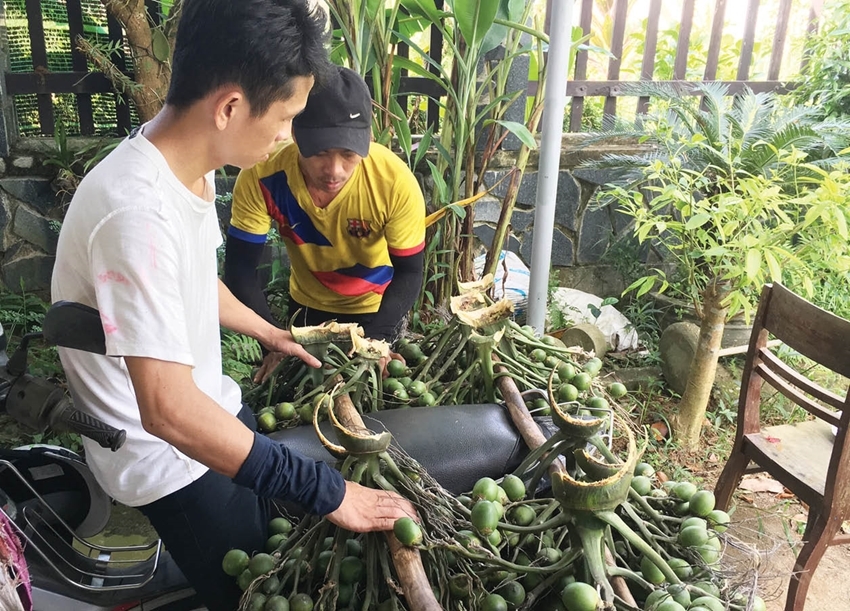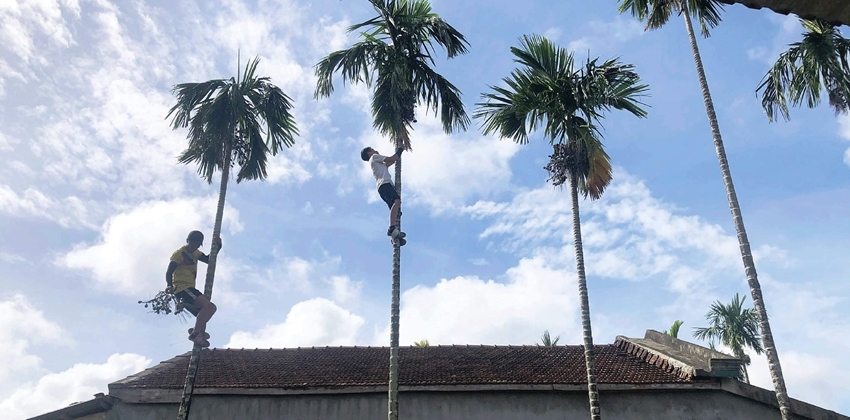 |
| With just a climbing belt and a small knife, harvesters can pick areca nuts from a tree in just a few minutes |
Quick climbing, fast picking
Looking at five areca palm trees in a garden house in Kim Long, Hue City, Ms. Nguyen Thi Loan, an areca nut trader from Phong Dien District, negotiates the price and then hooks her feet into the climbing belt, gripping a small knife in her hand as she bounces up the tree rhythmically. Seeing a woman climb the areca palm so skillfully, and even swinging from the top of one tree to another, the children playing below gather to clap and cheer. Some nearby men also come over to watch and express their admiration.
After paying for the areca nuts, Ms. Loan blushes at the homeowner's praise: “It’s not a big issue. My mother passed this skill down to me. I'm not particularly talented, but I had to become proficient to earn a living. If I can climb myself, I don’t have to hire others. Saving on labor costs helps me raise and educate my children.”
Throughout roads and countryside in the area this season, one frequently encounters bustling groups of areca nut traders engaged in a flurry of buying, selling, and transporting activities. The current price of areca nuts is around 20,000 dong per kilogram, depending on the type. On some major roads, drying kiln owners set up weighing stations to collect areca nuts from small-scale buyers. The areca nut season starts from mid-June to December and continues at intervals until the Lunar New Year. Buyers go out to harvest twice a day, in the morning and afternoon. They take days off when it rains because climbing becomes dangerous due to slippery conditions.
 |
| Two young men buying areca nuts in Nam Dong District |
Using a climbing belt, made of twisted rope, burlap, soaked areca sheaths, banana fiber…, and looping it around both legs, the climber clings to the tree trunk, bouncing rhythmically to ascend. When reaching the areca nut cluster, they use a small knife to make a clean cut and release the bunch, then loosen their legs to slide down to the ground in an instant. Thanks to the flexible nature of the areca palm, experienced climbers can swing from one tree to another continuously. At this point, the areca bunch is tucked against their thigh, and the harvester uses their strength to swing, causing the treetop to lean, allowing them to grab onto the adjacent tree. This method makes harvesting faster and more convenient, but only seasoned areca climbers can perform this technique.
Nam Dong mountainous district, the largest areca-growing region in the province, is perhaps where most areca traders and harvesters congregate. By chance, we met Nguyen Sy Tuan and his friend buying areca nuts from a local garden, allowing us to witness the art of areca harvesting firsthand. Young and strong, the two men swung from tree to tree swiftly and nimbly to harvest a single tree in a few minutes.
Having followed his parents in the areca nut trade since childhood, Tuan gradually gained experience and became an independent trader over the past 10 years. When areca prices are good, he invites his friend to work together, and when the season ends, they switch to rubber tapping. To ensure areca nut quality, the two don’t use poles for harvesting. “Each areca season requires a few tens of millions of dong as capital. Every day, the two of us harvest about 700-800 kilograms of nuts. So we have to climb quickly and pick fast to ensure high productivity,” said Tuan.
The wage for areca harvesting is calculated by weight, tree, or day, with the highest rate being 200,000-300,000 dong per workday. To ensure productivity and meet seasonal demands, hired areca climbers start their work early in the morning, sometimes working until early afternoon before taking a lunch break, then resuming work until sunset. This job is demanding because it requires traveling far and constantly using strength to swing and climb. Therefore, young people stick with it, but as their health declines, they eventually transition into other occupations.
Ups and downs
People in Hue still pass down the lullaby: “Ru em cho théc cho mùi/ Để mẹ đi chợ mua cau / vôi ăn trầu/ Mua cau / vôi chợ Quán chợ Cầu/ Mua cau Nam Phổ, mua trầu chợ Dinh” (Lull the baby to sleep soundly / So mother can go to the market to buy areca nuts / slaked lime for betel chewing / Buy areca nuts / slaked lime at Quan market or Cau market / Buy areca nuts from Nam Pho, buy betel leaves at Dinh market). The former Nam Pho area is now Tay Tri Nhon residential area, Phu Thuong Ward, Hue City. Time has changed many things. Villagers involved in areca and betel-related trades have gradually disappeared, leaving only old houses with aged areca palms as landscape features. The most prominent remnant of the once-thriving areca trade is the Can Lang Shrine, founded by dried areca nut traders and locally known as the Cau Kho (Dried Areca) Shrine.
Local villagers often sing the folk song “Con gái Nam Phổ ở lỗ trèo cau” (Nam Pho girls get naked climbing areca palms), or in another version “Con gái Nam Phổ ở lỗ nhìn cau” (Nam Pho girls get naked watching areca palms). Regardless of which verb is used in the sentence, its implication still refers to the famous areca-growing region of Nam Pho at that time.
Mr. Nguyen Phuong, the village Secretary of the Party and Head of Tay Tri Nhon Residential Area, Phu Thuong Ward, recalls: “The elders say that in the past, this village traded a lot of areca nuts. People hired workers to split and dry the nuts, then stored them in large earthenware jars for sale in the South and North. Thanks to the dried areca nut trade, many households became more prosperous. They established the Dried Areca Association, gathering areca traders from across the province, built a shrine in Nam Pho, and gathered annually on the 3rd day of the 3rd lunar month for worship.”
In the Tay Tri Nhon area, Mr. Nguyen Ky has the longest experience in the areca climbing trade, both in the old Nam Pho and today. At 16, Mr. Ky started harvesting areca nuts for his neighbors. At 20, he took up areca climbing as a profession and became the main worker for Mrs. De - a wealthy areca trader near Gia Lac market (now Phu Thuong).
Back then, Mrs. De traded from the city to many rural areas in districts of Phu Vang, Quang Dien..., buying about 4,000 - 5,000 trees each season. Mr. Ky was responsible for climbing and harvesting areca nuts. Some skilled women from My Loi village, Vinh My commune, Phu Loc district, were hired to split and dry the areca nuts. For over a decade working for Mrs. De harvesting areca, Mr. Ky went to work almost every day regardless of rain, wind, or floods, fearing that missing the season would make selling difficult. Mrs. De provided three meals a day and paid 200,000 dong per day. With this income over a decade ago, Mr. Ky's wife could stay home to take care of the household and children, while he covered the children's education expenses and family spending comfortably.
After years in the profession, Mr. Ky's arms and legs became muscular, but his palms and soles developed thick calluses. He had to replace his climbing belt every 10-15 days due to frequent use. Swinging from tree to tree became as natural to him as eating. Young men in Nam Pho said he could “fly” between areca trees with speed and accuracy, without needing to build momentum like others. Yet, there were still moments of misfortune. He remembers climbing an areca palm that had been half cut by a bomb fragment in Vinh Ve village, Phu My commune, Phu Vang district. Just as he reached the top and was about to pick the fruit, a sudden gust of wind bent the treetop, causing him to fall from a height of over 5 meters. Fortunately, he wasn't injured, but it gave him quite a scare. From then on, Mr. Ky became more careful, looking around and calculating his moves more cautiously when climbing trees.
At that time, Mr. Ky hired a few young men from the village to assist him. Each day, he could harvest 300 areca trees, a number few could surpass, making him a famous areca harvester in Nam Pho. “The most skilled ones could last three days, but most would climb for one day, take the pay, and quit because they couldn’t handle it,” recalls Mr. Ky. Now, although he has retired due to his old age, the memories of his profession still excite Mr. Ky when he talks about them.
Mr. Ky’s nephew-in-law, Tran Van Phap from Huong Xuan commune, Nam Dong district, started climbing areca palms at 19 but has since switched to construction work due to unstable income. Now using shovels and trowels to earn a living, Mr. Phap explains: “When you have a wife and children, you need a stable job. So, I had to change my livelihood. It may not seem like it, but that job really takes a toll on your health, constantly climbing, and by the end of the day, you're exhausted. Dangers lurk everywhere. It’s not as easy as people think. In Nam Dong district, several people have had accidents while harvesting areca, ending up in the hospital or disabled for life, becoming a burden to their families.”
Phap’s words remind me of Mr. Nguyen Phuong’s story when we visited the Can Lang shrine together: “Many people have achieved success and honor through this profession, but some have also lost everything because of it. Like two brothers in the neighborhood who were in this trade, one lost his life, and the other has been bedridden for decades, a truly pitiful situation that can’t be fully described. I suppose it’s a case of ‘live by the sword, die by the sword!’”.